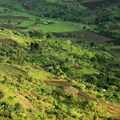Agriculture, forestry and fisheries minister Senzeni Zokwana says investing in the agricultural sectors is fundamental to eradicating poverty, hunger and malnutrition, particularly in rural areas where most of the region's poorest live.
“Agriculture is the key for economic transformation, food and nutrition security. About 70% of the region's population depends on agriculture for food, income and employment,” Zokwana said.
The minister was speaking during the regional commemoration of World Food Day held in Bunya Village, Namibia, on Tuesday, 30 October.
Held under the theme 'Our actions are our future. A #ZeroHunger world by 2030 is possible', the 2018 World Food Day marks 73 years since the Food and Agriculture Organization (FAO) was founded in 1945. The theme is in line with the 17 Sustainable Development Goals (SDGs), in particular SDG 1 of eradicating poverty in all its forms, and SDG 2 of ensuring zero hunger.
Speaking at the event, Zokwana noted that food and nutrition insecurity is a complex matter to address, as “it is fundamentally related to structural societal factors, including developmental issues such as access to land, credit, education and employment, as well as access to affordable agricultural inputs such as fertiliser, water and seeds”.
Regional food security outlook
The Southern African Development Community (SADC) region’s population is estimated at over 340 million with about 29.4 million people estimated to be food insecure in the 2018/19 consumption year.
South Africa is one of the four countries, including the Democratic Republic of the Congo, Malawi and Zimbabwe in the 11 member states that make up close to 90% of food insecure people.
According to a 2017 general household survey, the number of South Africans with inadequate or severely inadequate access to food stands at 13.9 million (25% of the population), of which those with severely inadequate access to food numbers 3.55 million (6.4%).
Decreases in food insecure populations are recorded in Namibia and Eswatini. The Consolidated Approach to Reporting Indicators of Food Security (CARI) indicates that 39% of rural Namibians are moderately food insecure and 1.4% severely food insecure.
In urban areas, 69.3% are food insecure and 1.1% severely food insecure. About 24% of children under the age of five are stunted.
Zokwana encouraged member states to put efforts to develop resilience-building initiatives including, but not limited to employment creation in rural areas, incorporating climate smart technologies in subsidies and conservation agriculture.
He also encouraged the states to strengthen collaborations, both at regional and national levels to assist food insecure populations and scale up safety net programmes, as they play a significant role in ensuring food and livelihood security, especially among the poor and the very poor households.
“Investments need to simultaneously increase small-scale farmers’ productivity and income; diversify farmers’ income through value chain development, and create more and better jobs for the rural poor,” the minister said.
SADC initiatives commended
Zokwana commended the SADC’s continuous and structured support, which remains critical.
In line with already existing SADC ministerial decisions, Zokwana said that South Africa has been further requested to lead the research work in the control of the Fall Army Worm and develop the regional control model, as well as the draft charter for the establishment of the SADC Regional Fisheries Monitoring Control and Surveillance Coordination Centre (MCSCC).
Zokwana said that ground work has been done for implementation of these legacy projects.
“These initiatives, plus others from Namibia, are key to food security and integration of the region. We all want to collectively control invasive pests and diseases, monitor, protect and conserve our marine resources, in order to ensure sustainable food security, especially for our vulnerable communities. In this way, a zero hunger world by 2030 would be in sight.














































